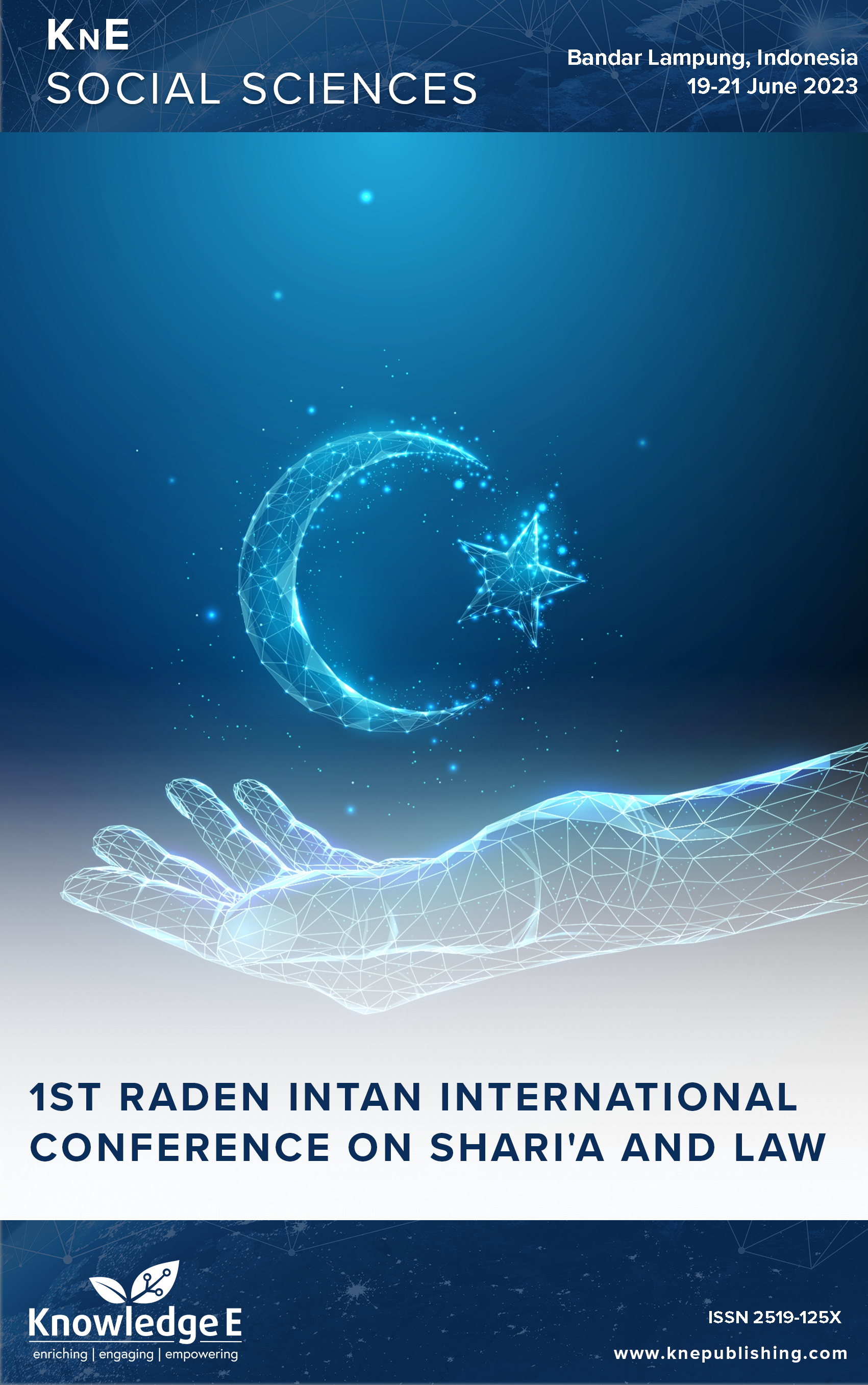Modernization of Shibhul Iddah for Men Perspective Compilation of Islamic Law
DOI:
https://doi.org/10.18502/kss.v9i2.15027Abstract
Iddah is the mass or waiting time for an ex-wife who has been divorced by her ex-husband. Mass iddah applies to women who have been divorced or because her husband died at which time the ex-wife has not been allowed to remarry with another man. Masa Iddah here is meant as a form of respect, mourning, and tolerance to the deceased and family. Honouring someone who has contributed to his life is a good thing and is encouraged in Islam. In this ever-evolving age, the author sees how the implementation of ’iddah is also directed at men. Then it would be more beautiful if the law applied to both. This study will examine how the regulations on the mass of iddah for men that have been listed in the compilation of Islamic law are then connected to the point of view of Islamic jurisprudence. How the role of fiqh law delivers these regulations so that these regulations are considered applicable in Indonesia. The analysis method used is in the form of descriptive analysis by explaining what is meant by the theory of ’iddah, the compilation of Islamic law and Islamic jurisprudence. Furthermore, from this presentation, an analysis of the postulates that explain ’iddah is carried out. The analysis in question is to analyze the verse about ’iddah to be made into law and applied to men using the theory of compilation of Islamic law.
Keywords: Shibhul ’Iddah male, compilation of Islamic law, interpretation
References
Dosen Fakultas Syari’ah UIN Raden Intan Lampung n.d.
DosenFakultas Syari’ah UIN Raden Intan Lampung n.d
Sarwat A. Fiqh Nikah. Jakarta: DU Publishing, 2011; 2011.
Al-Hamdani HSA. Risalah Nikah. Jakarta: Pustaka Amina; 1989.
Muslimeen A. ’Iddah and Ihdad of Modern Women. Court J Vol 2 No 2 2017:12.
Suyuthi U. Asbabun Nuzul: The cause of the descent of the Qur’anic Verse. Jakarta: Gema sani; 2008.
Syarifuddin A. Islamic Marriage Law in Indonesia: Between Fiqh Muamalat and Marriage Law. Jakarta: Kencana Pernada Media Group; 2009.
Saeed A. The Qur’an of the 21st Century: Contextual Tafsir. Bandung: Mizan; 2015.
Mustaqim A. Research methods of the Qur’an and Tafsir. Yogyakarta: Idea Pres; 2015.
Zuhaili W. al-Fiqh al-Islami wa Adillatuhu, Juz VII. Damascus: Dar al-Fikr; 1996.
Asep Sobari et al. Sunnah Fiqh. AlI’tishom 2013;2:89.
Nasution A. Encyclopedia of Islam. Jakarta: Ichtiar Van Hoeve; 1999.
Noviani R. Ibn Qayyim’s views on the “upper Iddah.” UIN Ar-Raniry Darussalam, 2017.
Law No. 1 of 1974 concerning Marriage. 1974.
Sha’ban Z ad-D. Ushul al-Fiqh al-Islami. Egypt: Mathba’ah Dar al-Ta’lif; 1965.
Amal TA. Islam and the challenge of modernity: A Study of Fazlur Rahman’s Legal Thought. Bandung: Mizan; 1996.
Sugiyono. Quantitative, qualitative, combination, R&D and evaluation research approaches. Res Methodol 2017:99.
Zuhaili W. Fiqhul Islam Wa adillatuh. Gema Insa Darul Fikri Terj Vol 9 n.d.:539.
Compilation of Islamic Law Article 153. n.d.
See Article 3 of Law No. 1 of 1974 concerning Marriage points 1 and 2 and KHI Article 56 Points 1, 2 and 3. n.d.
Zahrah MA. Al Ahwal Al Shakhsiyyah. Berut: cet II, Dar Al-Fikri Al Araby; 1957.
The principle of Monogamy as explained in article 3 paragraph 1 Supplement to the State Gazette of the Republic of Indonesia No. 3019. n.d.
Zuhaili W. al-Fiqh al-Islami wa Adillatuhu, Juz VII. Damascus: Dar al-Fikr; 1996.
The talaq ba’in sughra is talaq that cannot be referred to but can be a new marriage contract with his ex-wife even with the period of iddah. The categories of talaq ba’in sughra, namely: Talaq that occurs qobla al-dukhul, Talaq with ransom or khuluk and n.d.
The scholars agreed as quoted by Jamal al-Banna that the benefit in question is the benefit in accordance with the Shari’a. In line with this opinion, Abu Zahra detailed that the benefits include five things, namely to preserve religion, soul, reason, off n.d.
Aziz A. Islamic Neo-Modernism in Indonesia. Comp Anal Sharia Maqasid Gend Equal Law ’Iddah Scarism 1999:182.
Hidayati NF. ender Review of the Construction of ’iddah and Ihdad in the compilation of Islamic Law. Pasaca Sarjana UIN Sunan Kalijaga, 2018.
Khoiri, Ahmad and AM. “Iddah and Ihdad for Career Women: Islamic Legal Perspectives.” J Islam Law 1, No 2 2020:79. DOI: https://doi.org/10.24260/jil.v1i2.71
The word hikmah, is the most widely used term in the discussion of maqasid or the purpose of shari’a. While the word illat, in the use of the term contains two meanings. First, the fixed clear nature that is in accordance with the law, is established by t n.d.
Al-Banna J. “Nahwa Fiqh Jadid 3”, translated Hasibullah and Zuhairi Misrawi, Manifesto Fiqh Baru 3. Jakarta: Erlangga; 2008.
See Zaky ad-Din Sha’ban in his book Ushul al-Fiqh al-Islami Mathba’ah Dar al-Ta’lif, Egypt, 1965, p. 173 n.d.
Muhammad Abu Zahrah, Al Ahwal Al Shakhsiyyah, cet II, Berut. Dar Al-Fikri Al Araby, 1957. H.55 n.d.
Nurhadi, Nurhadi. “Law No. 1 of 1974 on Marriage (Marriage) is reviewed from Maqashid Sharia.” UIR Law Review (2018). Saputera, Abd. rahman Adi. “The concept of justice in divorce cases for civil servants.” Istinbath : Journal of Law (2018). H.67. n.d.
Juliara J and I. The merging of the iddah of pregnant women and the death of husbands. J Islam Fam Law Samara 1, No 1 2017:55.
Syarifuddin, Amir. 2009. Islamic marriage law in Indonesia: Between Fiqh Muamalat and Marriage Law. Jakarta: Kencana Pernada Media Group. H.67. n.d.
Compilation of Islamic Law in Indonesiaa n.d.
Rahman F. Islam and modernity; tranformation of an intllectual tradition. Chichago Uinversity Press: 1982.

